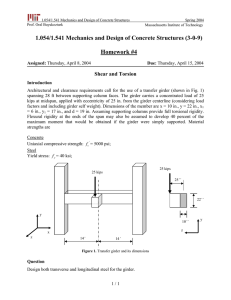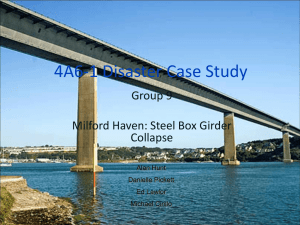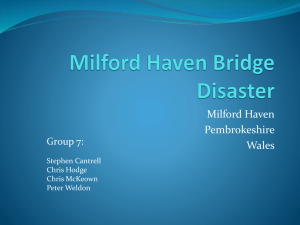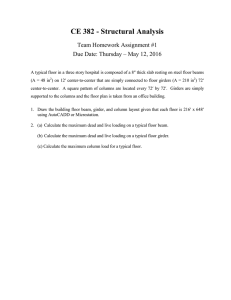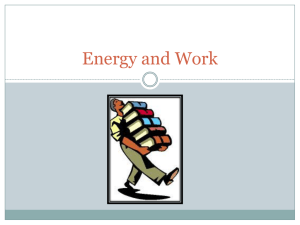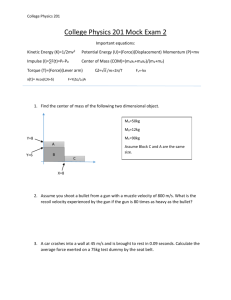Caluculation of Unsteady Aerodynamic Forces by CFD and Their
advertisement
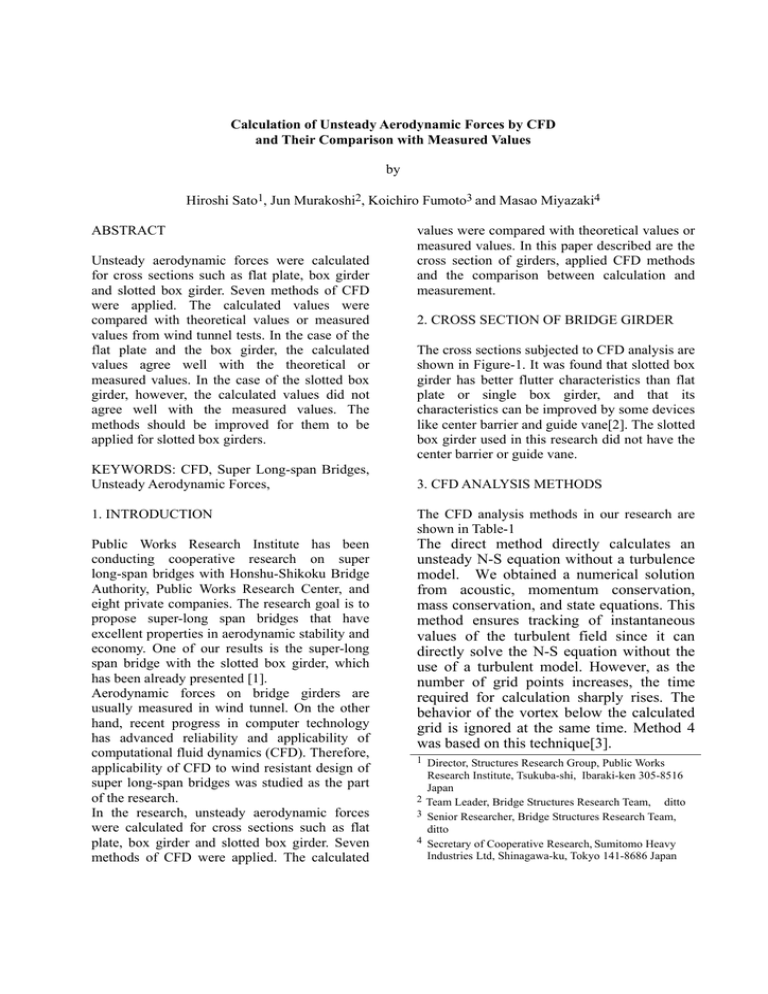
Calculation of Unsteady Aerodynamic Forces by CFD
and Their Comparison with Measured Values
by
Hiroshi Sato1, Jun Murakoshi2, Koichiro Fumoto3 and Masao Miyazaki4
ABSTRACT
Unsteady aerodynamic forces were calculated
for cross sections such as flat plate, box girder
and slotted box girder. Seven methods of CFD
were applied. The calculated values were
compared with theoretical values or measured
values from wind tunnel tests. In the case of the
flat plate and the box girder, the calculated
values agree well with the theoretical or
measured values. In the case of the slotted box
girder, however, the calculated values did not
agree well with the measured values. The
methods should be improved for them to be
applied for slotted box girders.
KEYWORDS: CFD, Super Long-span Bridges,
Unsteady Aerodynamic Forces,
1. INTRODUCTION
Public Works Research Institute has been
conducting cooperative research on super
long-span bridges with Honshu-Shikoku Bridge
Authority, Public Works Research Center, and
eight private companies. The research goal is to
propose super-long span bridges that have
excellent properties in aerodynamic stability and
economy. One of our results is the super-long
span bridge with the slotted box girder, which
has been already presented [1].
Aerodynamic forces on bridge girders are
usually measured in wind tunnel. On the other
hand, recent progress in computer technology
has advanced reliability and applicability of
computational fluid dynamics (CFD). Therefore,
applicability of CFD to wind resistant design of
super long-span bridges was studied as the part
of the research.
In the research, unsteady aerodynamic forces
were calculated for cross sections such as flat
plate, box girder and slotted box girder. Seven
methods of CFD were applied. The calculated
values were compared with theoretical values or
measured values. In this paper described are the
cross section of girders, applied CFD methods
and the comparison between calculation and
measurement.
2. CROSS SECTION OF BRIDGE GIRDER
The cross sections subjected to CFD analysis are
shown in Figure-1. It was found that slotted box
girder has better flutter characteristics than flat
plate or single box girder, and that its
characteristics can be improved by some devices
like center barrier and guide vane[2]. The slotted
box girder used in this research did not have the
center barrier or guide vane.
3. CFD ANALYSIS METHODS
The CFD analysis methods in our research are
shown in Table-1
The direct method directly calculates an
unsteady N-S equation without a turbulence
model. We obtained a numerical solution
from acoustic, momentum conservation,
mass conservation, and state equations. This
method ensures tracking of instantaneous
values of the turbulent field since it can
directly solve the N-S equation without the
use of a turbulent model. However, as the
number of grid points increases, the time
required for calculation sharply rises. The
behavior of the vortex below the calculated
grid is ignored at the same time. Method 4
was based on this technique[3].
1 Director, Structures Research Group, Public Works
Research Institute, Tsukuba-shi, Ibaraki-ken 305-8516
Japan
2 Team Leader, Bridge Structures Research Team, ditto
3 Senior Researcher, Bridge Structures Research Team,
ditto
4 Secretary of Cooperative Research, Sumitomo Heavy
Industries Ltd, Shinagawa-ku, Tokyo 141-8686 Japan
When calculation is made according to the
Reynolds-Averaged Navier Stokes Equation,
turbulence model is required. The k-ε model, the
representative model of differentiation method,
obtains turbulent stress by solving the transport
equation of the modeled turbulent energy k and
ε. The k-ε model was applied to the Method 3
and 5. In Method1[4], k-ω SST model[5] was
used among double equation models because of
Bardina's performance evaluation[6]. In Method
2[7], q-ω model[8] which was based on the k-ε
model was used.
Large eddy simulation (LES method) does not
use Reynolds’ equation. This method takes an
in-grid space average of the N-S equation.
Smagorinsky’s model is frequently used.
Method 6 adopted the LES method [9]
The vortex point method introduces the basic
solution of a differential equation, instead of
solving the differential equation for fluid motion,
to formulate an integral equation and divide the
boundary into a finite number of elements for
boundary integration. The advantage of this
method over alternative analysis methods is its
small number of unknowns, whose number of
dimension is less by one than the other methods.
However, the method is invalid unless that the
basic solution required to convert the differential
equation into an integral equation is already
obtained. Method 7 was based on this
technique[10]
In FDM, the coordinate system which suits an
object boundary well must be used to increase
accuracy.(Method1, 3 and 4)[11][4]. The merits
of FVM are its easiness to take boundary
conditions and to acquire preservation (Method
2 and 5)[12][7]. In FEM, complicated boundary
conditions can be treated and accuracy can be
increased locally (Method 6).[9]
]
{ [
+ B [L ω θ + L ωθ ′]}
M = πρ {B [M ω z + M ωz ′]
+ B [M ω θ + M ωθ ′]}
L = πρ B 2 LZR ω 2 z + LZI ωz ′
3
θR
2
θI
3
2
ZR
4
(1)
θR
2
ZI
θI
(2)
where L: lift; M: aerodynamic moment; ρ: air
density; B: girder width; V: velocity; z: vertical
displacement; θ: torsional displacement; and ω:
circular frequency.
4.2 Flat Plate
Fig.4 compares the calculated and theoretical
values of unsteady aerodynamic forces of the
flat plate. Although there are some errors in the
real part of lift during bending excitation
obtained and the imaginary part of lift during
torsional excitation, the calculated and
theoretical values are almost identical. As for the
flat plate, the accuracy of the CFD methods
seems relatively high. This accuracy is probably
caused by its flatness of the section. Because of
its flatness, the effect of viscosity appears only
in the upstream and downstream ends of the
section. Therefore the difference in calculation
methods or in turbulence modeling does not
affect much.
4. COMPARISON
OF CALCULATED FORCES
4.3 Box Girder
Fig.5 compares the calculated and measured
values of unsteady aerodynamic forces of the
single
box
girder
section.
Although
CFD-analyzed and experimental values do not
agree as well as they do in the case of the flat
plate, an approximate trend can be estimated
from the CFD methods. The reasons seem to be
as follows: firstly, the handrails at the upstream
and downstream ends of the section and the
protective fence in the median strip zone were
excluded from the present research; secondly,
the section of the box girder was very flat.
4.1 Definition of Unsteady Aerodynamic Forces
4.4 Slotted Box Girder
The calculated unsteady aerodynamic forces
were compared with theoretical values and
experimental values. The definition of
unsteady aerodynamics forces are as
follows:
Fig.6 compares the calculated and measured
values of unsteady aerodynamic forces of
the slotted box girder section. The
difference between the CFD-analyzed and
wind tunnel experimental values tends to be
larger than that of the single box girder.
Among the CFD methods, values calculated
according to the Method 6 agrees fairly well
with the measured values. Method 6 adopted
the LES Method as the turbulence model.
The LES Method seems applicable even
where flow is strongly unsteady.
As shown in Fig.3, the section of the double box
girder forms a very complicated vortex from
mutual interference between a vortex discharged
from the upstream girder end and a shear layer
separated from the front edge of the downstream
girder. Therefore, the vortex behavior needs to
be simulated accurately. Since vortex behavior is
seriously affected by the turbulence model,
improvement of the turbulence model seems to
be important.
5. CONCLUSIONS
Unsteady aerodynamic
for the flat plate, box
girder. Seven methods
The calculated values
forces were calculated
girder and slotted box
of CFD were applied.
were compared with
theoretical values or measured values from
wind tunnel tests.
It was found that unsteady aerodynamic forces
of the flat plate and the flat single box girder can
be predicted fairly well by the CFD analysis.
The CFD analysis can be applicable to the
relatively flat single box section.
On the other hand, satisfactory results were not
obtained for the slotted box girder, probably due
to the complicated flow in the slot. Improvement
of the turbulence model seems to be effective to
improve the accuracy of calculation.
This paper is part of the results of the
cooperative research conducted by Public Works
Research Institute, Honshu-Shikoku Bridge
Authority, Public Works Research Center, and
eight private companies. We would like to take
this opportunity to mention that the CFD
analysis for the flat plate, single box girder, and
slotted box girder were conducted by Mr. S.
Kuroda
at
Ishikawajima-Harima
Heavy
Industries Co., Ltd., Mr. H. Kawamoto at
Kawasaki Heavy Industries, Ltd., Dr. K.
Shimada at Shimizu Corporation, Mr. D.
Ichishima at Sumitomo Heavy Industries, Ltd.,
Mr. S. Shirai at Hitachi Zosen Corporation, Mr.
S. Watanabe at Mitsui Engineering &
Shipbuilding Co., Ltd., and Mr. S. Sugiyama at
Mitsubishi Heavy Industries, Ltd. We would like
to acknowledge and thank them for their
cooperation.
6. REFERENCES
1.
H. Sato, N. Hirahara, K. Fumoto, S.
Hirano and S. Kusuhara.: Full aeroelastic
model test of a super long-span bridge
with slotted box girder, Journal of Wind
Engineering and Industrial Aerodynamics,
Vol. 90, 2002.
2.
H. Sato, S. Kusuhara, K. Ogi and H.
Matsufuji.: Aerodynamic characteristics of
super long-span bridges with slotted box
girder, Journal of Wind Engineering and
Industrial Aerodynamics, Vol. 88, 2000.
3.
D.Ichishima.: Unified Theory for Solving
Multi - Flow Problems, J. of Technical
Paper Vol.45 No.134, Sumitomo Heavy
Industries Ltd.
4. S.Kuroda.: Numerical Computations of
Unsteady Flows for Airfoils and
Non-airfoil Structures, Proc. 31st AIAA
Fluid Dynamics Conference & Exhibit,
Anaheim, C, 2001.
5. Menter,F.R.: Two-Eqation Eddy-Viscosity
Turbulance Models, AIAA journal ,
vol.32,No.8, 1994.
6. Bardina,J.E Huang,P.G and Coakley.T.J.:
Turbulence Modeling Validation,
Testing and Development, NASA Techinical
Memorandum 110446,1997.
7. H.Kawamoto, H.Yoshida and T.Oryuu.:
2-Dimensional Steady Turbulent Flow
Simulation of Static Aerodynamic Forces
of Bridge Girder Sections, Proc. 16th
National Symposium on Wind Engineering,
Tokyo, 2000
8. Coakley.T.J.: Turbulence Modeling Method
for the Compressible Navier - Stokes
Eqations, AIAA paper 83-1693,1983.
9.
S.Watanabe,H.Inoue and K.Fumoto.: A
Study on Static Aerodynamic Forces of
Box Girders Using Computational Fluid
Dynamics, Proc. The Second International
Symposium on Advances in Wind and
Structures, 2002.
10. T.Inamuro. T.Adachi and H.Sakata.: A
Numeral Analysis of Unsteady Separated
Flow By Vortex Shedding Model, Bulletin
of JSME, vol.26, No.222, 1983.
11. K.Shimada, T.Wakahara and H.Sato.:
Prediction of Unsteady Wind Force acting
on the Separated Box Girder Cross-Section,
In J. of Wind Engineering, No.89, Proc.
The Fifth Asia-Pacific Conference on Wind
Engineering, Kyoto, 2001.
12. S.Shirai, and T.Ueda,.: Aerodynamic
Simulation By CFD on Flat Box Girder of
Super-Long Span Suspension Bridge, In J.
of Wind Engineering, No.89, Proc. The
Fifth Asia-Pacific Conference on Wind
Engineering, Kyoto, 2001.
13. N.Hirahara, et al.: An Investigation on
Wind-Resistance and Economic
Improvements of Super Long Span
Suspension Bridges Synoptic Report,
Cooperative Research Report of PWRI,
No.279, 2002.
Table 1 CFD Approaches
Methods
Number
1
Basic Equation
Calculation
Reynolds-Averaged Navier Stokes Equation
Turbulence
Model
k-ω
2
Reynolds-Averaged Navier Stokes Equation
q-ω
Finite Volume Method
3
Reynolds-Averaged Navier Stokes Equation
k-ε
Finite Difference Method
4
Navier Stokes Equation
-
Finite Difference Method
5
Reynolds-Averaged Navier Stokes Equation
k-ε
Finite Volume Method
6
Reynolds-Averaged Navier Stokes Equation
Finite Element Method
7
Laplace Equation (Vortex points method)
Large
Eddy Simulation
-
Finite Difference Method
Boundary Element
Method
0.02B
B
Flat Plate
0.0594B
0.0514B
B
Box Girder
0.0594B
0.224B
0.388B
B
Slotted Box Girder
Fig.1 Cross Section
L
M
U
Θ
z
B
Fig.2 Definition of Forces and Displacement
Fig.3 Flow around Slotted Box Girder
0.00
10.00
Theodorsen
(1)
(2)
(3)
(4)
(5)
(6)
(7)
-0.40
-0.60
6.00
LθR
LZR
Theodorsen
(1)
(2)
(3)
(4)
(5)
(6)
(7)
8.00
-0.20
4.00
2.00
-0.80
0.00
0.00
0.05
0.10
0.15
fB/U
0.20
0.25
0.00
0.0
0.05
0.10
0.15
fB/U
0.20
0.25
0.50
-0.5
0.00
Theodorsen
(1)
(2)
(3)
(4)
(5)
(6)
(7)
Theodorsen
(1)
(2)
(3)
(4)
(5)
(6)
(7)
-1.5
-2.0
-2.5
-3.0
0.00
0.05
0.10
0.15
fB/U
0.20
LθI
LZI
-1.0
-0.50
-1.00
-1.50
0.25
0.00
0.05
-0.05
MθR
MZR
0.15
fB/U
0.20
0.25
Theodorsen
(1)
(2)
(3)
(4)
(5)
(6)
(7)
2.00
Theodorsen
(1)
(2)
(3)
(4)
(5)
(6)
(7)
-0.10
-0.15
0.00
0.05
0.10
0.15
fB/U
0.20
1.50
1.00
0.50
0.00
0.25
0.00
0.05
0.10
0.15
fB/U
0.20
0.25
0.00
0.00
-0.10
-0.20
Theodorsen
(1)
(2)
(3)
(4)
(5)
(6)
(7)
-0.40
-0.60
MθI
MZI
0.10
2.50
0.00
Theodorsen
(1)
(2)
(3)
(4)
(5)
(6)
(7)
-0.20
-0.30
-0.40
-0.80
-0.50
0.00
Fig.4
0.05
0.05
0.10
0.15
fB/U
0.20
0.25
0.00
0.05
0.10
0.15
fB/U
0.20
0.25
Comparison between Experimental and CFD values for the Unsteady Aerodynamics
of a Flat Plate
10.00
0.00
-0.10
Theodorsen
Exp.
(1)
(2)
(3)
(4)
(5)
(6)
(7)
-0.40
-0.50
-0.60
-0.70
6.00
LθR
-0.30
LZR
Theodorsen
Exp.
(1)
(2)
(3)
(4)
(5)
(6)
(7)
8.00
-0.20
4.00
2.00
-0.80
0.00
0.00
0.05
0.10 0.15
fB/U
0.20
0.00
0.25
0.0
0.05
0.10 0.15
fB/U
0.20
0.25
0.50
-0.5
LZI
Theodorsen
Exp.
(1)
(2)
(3)
(4)
(5)
(6)
(7)
-1.5
-2.0
-2.5
-3.0
0.00
0.05
0.10 0.15
fB/U
0.20
LθI
0.00
-1.0
-0.50
-1.00
-1.50
0.25
0.00
0.05
2.00
-0.05
Theodorsen
Exp.
(1)
(2)
(3)
(4)
(5)
(6)
(7)
-0.10
-0.15
0.00
0.05
0.10 0.15
fB/U
0.20
MθR
MZR
0.05
0.10 0.15
fB/U
0.20
0.25
2.50
0.00
Theodorsen
Exp.
(1)
(2)
(3)
(4)
(5)
(6)
(7)
1.50
1.00
0.50
0.00
0.25
0.00
0.05
0.10 0.15
fB/U
0.20
0.25
0.00
0.00
-0.10
Theodorsen
Exp.
(1)
(2)
(3)
(4)
(5)
(6)
(7)
-0.40
-0.60
-0.80
Theodorsen
Exp.
(1)
(2)
(3)
(4)
(5)
(6)
(7)
-0.20
MθI
-0.20
MZI
Theodorsen
Exp.
(1)
(2)
(3)
(4)
(5)
(6)
(7)
-0.30
-0.40
-0.50
0.00
Fig.5
0.05
0.10 0.15
fB/U
0.20
0.25
0.00
0.05
0.10
0.15
fB/U
0.20
Comparison between Experimental and CFD values for the Aerodynamics
of a Single Box Girder
0.25
0.20
10.00
0.00
8.00
-0.20
6.00
-0.60
LθR
LZR
Theodorsen
Exp.
(1)
(2)
(3)
(4)
(5)
(6)
(7)
-0.40
Theodorsen
Exp.
(1)
(2)
(3)
(4)
(5)
(6)
(7)
4.00
2.00
0.00
-0.80
0.00
0.05
0.10
0.15
fB/U
0.20
0.00
0.25
0.05
0.10
0.15
fB/U
0.20
0.25
0.50
0.0
-0.5
0.00
LZI
-1.5
-2.0
-2.5
LθI
Theodorsen
Exp.
(1)
(2)
(3)
(4)
(5)
(6)
(7)
-1.0
-1.00
-1.50
-3.0
0.00
0.05
0.10
0.15
fB/U
0.20
0.00
0.25
0.05
2.00
0.00
1.50
MθR
MZR
Theodorsen
Exp.
(1)
(2)
(3)
(4)
(5)
(6)
(7)
-0.50
-0.05
-0.10
Theodorsen
Exp.
(1)
(2)
(3)
(4)
(5)
(6)
0.05
0.10
0.15
fB/U
0.20
0.25
Theodorsen
Exp.
(1)
(2)
(3)
(4)
(5)
(6)
(7)
1.00
0.50
(7)
0.00
-0.15
0.00
0.05
0.10
0.15
fB/U
0.20
0.00
0.25
0.00
0.00
-0.10
-0.10
MZI
-0.30
-0.40
-0.50
0.05
0.10
0.15
fB/U
0.20
0.25
0.20
0.25
Theodorsen
Exp.
(1)
(2)
(3)
(4)
(5)
(6)
(7)
-0.20
-0.30
-0.40
-0.50
0.00
Fig.6
0.10
0.15
fB/U
MθI
Theodorsen
Exp.
(1)
(2)
(3)
(4)
(5)
(6)
(7)
-0.20
0.05
0.00
0.05
0.10
0.15
fB/U
0.20
0.25
Comparison between Experimental and CFD values for the Unsteady Aerodynamics
of a Slotted Box Girder
